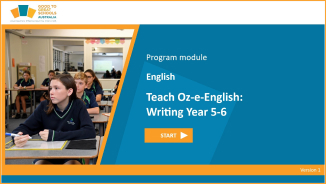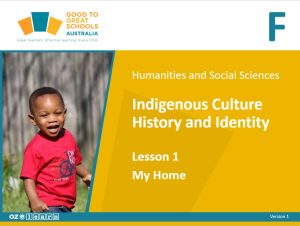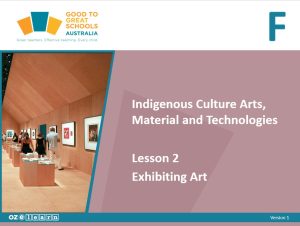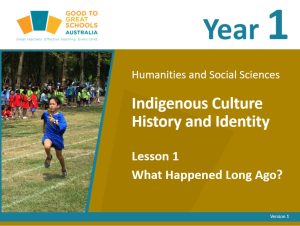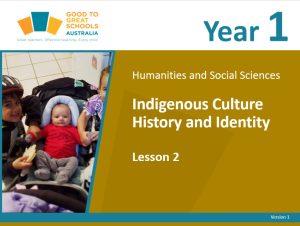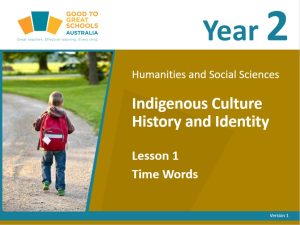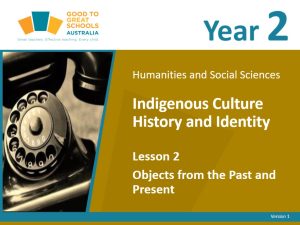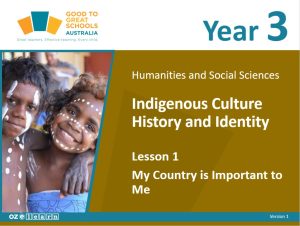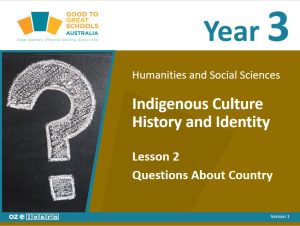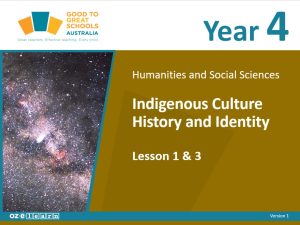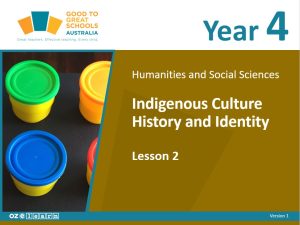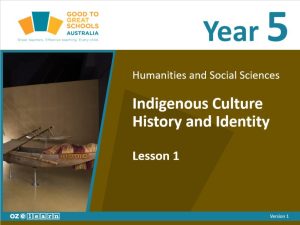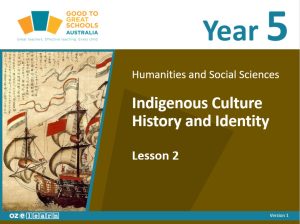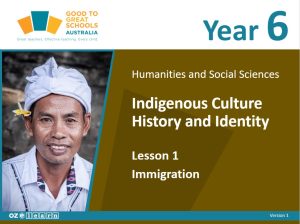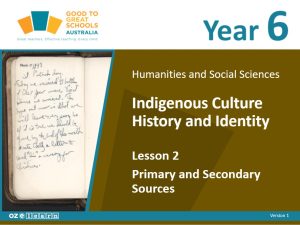Indigenous Culture History and Identity
Years F–6
Free Starter Lessons
Year Overview
Foundation Year – Me and My Family
Australian Curriculum Content Descriptions
Overview
Students investigate their family history and use drawings about, and photographs and objects from, their family history.
They share their family history to identify similarities and differences between families. They relate their family history and respond to collaboratively developed questions in an interview.
Learning Objectives
In Lessons 1 to 18, students learn to:
- draw and label the people they live with
- explain how people are related to each other in a family
- draw a family web
- identify five people who love and care for them
- identify where they and their parents are from
- describe places that are important to them
- describe groups and teams that are important to them
- describe their favourite things
- create questions for their families to answer
- create a family treasure chest
- recognise events
- describe events that are important to their family
- share their important family events with their class
- share their portfolios with their families and classmates.
Assessment
- Knowledge and Understanding Test (Lesson 18)
- Assessment Tasks for Portfolio (Lessons 1, 3, 4, 5, 6, 7, 10, 11, 12, 14)
Complete This Unit
Lesson 1: My Home
Lesson 2: Family
Lesson 3: My Family Web
Lesson 4: My Top Five
Lesson 5: Where Do I Come From?
Lesson 6: Important Places to Me
Lesson 7: Important Groups and Teams to Me
Lesson 8: My Favourite Things
Lesson 9: My Favourite Things
Lesson 10: My Family Treasure Chest – Part 1
Lesson 11: My Family Treasure Chest – Part 2
Lesson 12: My Family Treasure Chest – Part 3
Lesson 13: All About Events
Lesson 14: My Family’s Events
Lesson 15: Sharing Important Events
Lesson 16: Portfolio
Year 1 – What Happened Long Ago?
Australian Curriculum Content Descriptions
Overview
Students learn to describe the past, and can discuss and compare how life was different in the past to today by viewing selected artefacts, and build their understanding of the cultural and/or historical importance of specific places.
Learning Objectives
In Lessons 1 to 29, students learn to:
- use common words to describe the sequence of time
- create a timeline to show when important events in their lives happened
- identify how machines and other inventions changed the way people live
- create a simple machine which shows one way that work was made easier by the creation of machines and new inventions
- identify traditional foods from Cape York
- identify how changes have occurred over time and will assist in making bush bread
- identify traditional houses and shelter developed in northern Australia
- create a model of a traditional Indigenous shelter
- identify traditional ways that the Indigenous Peoples of Australia communicated
- identify traditional clothing from Cape York
- create jewellery using salt dough
- identify artefacts to learn about how people lived in the past
- identify what a special place is and what makes it special
- create a photo collage to show places in their school that are special to them
- identify places and/or buildings of significance in their local community
- create examples of rock art using traditional methods
- identify the types of questions that can be asked to get the most information
- identify how to conduct an interview with a community member elder
- organise and conduct an interview with a member of the school community.
Assessment
- Students will present a portfolio to showcase their understanding of the unit of work – What Happened Long Ago?
- Students will complete a content test to demonstrate their knowledge of the unit of work – What Happened Long Ago?
Complete This Unit
Lesson 1: Time Words
Lesson 2: A Timeline of My Life
Lesson 3: Time Observations
Lesson 4: Pictures of Time
Lesson 5: Changes from Past to Present
Lesson 6: Simple Machines
Lesson 7: Food Culture
Lesson 8: Bush Bread
Lesson 9: Traditional Housing
Lesson 10: Building a House
Lesson 11: Communications
Lesson 12: Building a House – continued
Lesson 13: Traditional Clothing
Lesson 14: Making Jewellery
Lesson 15: Identifying Artefacts
Lesson 16: Making Jewellery continued
Lesson 17: Traditional Games Part 1
Lesson 18: Traditional Games Part 2
Lesson 19: Traditional Games Part 3
Lesson 20: Traditional Games Part 4
Lesson 21: Special Places
Lesson 22: My School is Special
Lesson 23: Significant Sites
Lesson 24: My School is Special – continued
Lesson 25: Rock Art
Lesson 26: Questions About the Past
Lesson 27: Preparing for an Interview
Lesson 28: Practising an Interview
Lesson 29: The Interview
Lesson 30: Content Test
Lesson 31: Sharing Portfolios
Year 2 – My Community Across Time
Australian Curriculum Content Descriptions
Overview
Students explore what art is and what it can look like. They learn that anyone can be an artist. The elements of art are explored to develop an understanding of how artworks are created.
Students learn that artists can express their ideas, observations and imagination through different techniques. They develop an awareness of what an art exhibition is and what it means to exhibit art.
Learning Objectives
In Lessons 1 to 18, students learn to:
- sequence events using time words
- create a timeline of changing technologies
- compare objects from the past and present
- create a timeline of their community
- explain how daily life in their community has changed over time
- describe the importance of significant people in the local community
- describe significant local sites
- explore points of view about a historical site
- pose historical questions about a significant local site
- find information in sources
- recognise structures and language features of a historical narrative
- plan a historical narrative
- draft the beginning of a historical narrative
- draft the middle of a historical narrative
- draft the end of a historical narrative
- edit and publish a historical narrative
- share their historical narrative.
Assessment
- Knowledge and Understanding Test (Lesson 18)
- Historical Narrative (Lessons 12–17)
Complete This Unit
Lesson 1: Time Words
Lesson 2: Objects from the Past and Present
Lesson 3: Comparing Objects
Lesson 4: Timeline of My Community
Lesson 5: My Changing Community
Lesson 6: Significant People
Lesson 7: Historical Sites
Lesson 8: Identify Point of View
Lesson 9: Pose Historical Questions
Lesson 10: Locate Information
Lesson 11: Introduction to Historical Narratives
Lesson 12: Historical Narrative – Planning
Lesson 13: Historical Narrative Beginning
Lesson 14: Historical Narrative – Middle
Lesson 15: Historical Narrative – End
Lesson 16: Historical Narrative – Publishing
Lesson 17: Sharing
Lesson 18: K and U Test
Year 3 – Importance of Country and Community
Australian Curriculum Content Descriptions
Overview
Students will identify the importance of acknowledging Aboriginal and Torres Strait Islander peoples as Australia’s first people, and the ways that this is achieved.
Students understand that participation in events helps contribute to identity and that events, celebrations, commemorations and gatherings can be held to acknowledge significant moments of the past. Students examine the different celebrations that occur throughout Australia, including traditional celebrations and celebrations of peoples in other parts of the world.
Learning Objectives
In Lessons 1 to 18, students learn to:
- describe the importance of Country/Place to Aboriginal and/or Torres Strait Islander peoples
- ask questions about Country to local Elders and record their responses
- identify the symbolism on the flags of Australia and recognise their connection to Country
- locate dates and events of the lives of significant Australians on a timeline
- identify and describe changes and continuities in our community
- identify and describe changes to different parts of our community
- create a timeline showing the changes to our community
- write a diary entry from the point of view of a community member from the past
- identify and describe Australia’s coat of arms
- identify and describe Australian celebrations
- identify and describe Australian commemorations
- research and present information about an Australian celebration or commemoration
- identify and describe international celebrations
- identify and describe international commemorations
- research and present information about an international celebration or commemoration
- acknowledge and listen to different points of view
- debate a topic in teams.
Assessment
- Knowledge and Understanding Test (Lesson 18)
- Assessment Task (Compiled from Lessons 1, 2, 4, 5, 7, 8, 11, 13, 16, 17)
Complete This Unit
Lesson 1: My Country is Important to Me
Lesson 2: Questions About Country
Lesson 3: Flags and Symbols
Lesson 4: Significant Australians
Lesson 5: Changes and Continuity
Lesson 6: Changes to Our Community
Lesson 7: Community Timeline
Lesson 8: Diary from the Past
Lesson 9: Australia’s Coat of Arms
Lesson 10: Australian Celebrations
Lesson 11: Australian Commemorations
Lesson 12: Australian Celebrations and Commemorations
Lesson 13: International Celebrations
Lesson 14: International Commemorations
Lesson 15: International Celebrations and Commemorations
Lesson 16: Point of View
Lesson 17: Debate
Lesson 18: K and U Test
Year 4 – Our Universe: Creation and Change over Time
Australian Curriculum Content Descriptions
Overview
Students learn about the creation of the universe, including cultural, religious and scientific theories such as the Big Bang. They learn that Earth orbits a star called the sun, that it rotates on a tilted axis, and how these things affect life on Earth.
Students learn how evidence can help us learn about Earth’s past flora and fauna and how they can adapt to their environment. They explore our universe as a continually growing and changing planet that needs to be looked after into the future.
Learning Objectives
In Lessons 1 to 24, students learn to:
- describe the universe within which we live and the scientific theory of its creation
- create a model of the solar system
- describe how the process of Earth’s rotation on its axis affects people
- identify other beliefs as to how our world and the things in it were created
- create a sundial to show an early way of telling time
- examine the themes of Dreamtime stories
- describe the fields that scientists work within, helping us to know more about our world in the past, present and future
- explain likely theories as to why dinosaurs became extinct
- describe the megafauna of Australia
- examine a Dreamtime story that tells us about the Aboriginal peoples’ relationship with megafauna and reflect on what life was like in this period
- describe the adaptations flora and fauna have made over time
- create a postcard showing Australian megafauna
- describe the adaptations flora and fauna have made over time
- identify changes to the universe and justify personal ideas about the future of the universe.
Assessment
- Students will complete a content test to demonstrate their knowledge of the unit of work.
- Students will complete a rich task requiring them to create a game relating to a concept or topic learnt throughout the unit.
- Students will complete set activities throughout the course of the unit and collate them in their history books. These are referred to as portfolio items.
Complete This Unit
Lesson 1: Describe Universe Part 1
Lesson 2: Solar System Activity
Lesson 3: Describe Universe Part 2
Lesson 4: Telescope Activity Part 1
Lesson 5: Describe Earth’s Movements
Lesson 6: Telescope Activity Part 2
Lesson 7: Identify Beliefs Part 1 Scientific
Lesson 8: Earth Orbiting Sun Activity
Lesson 9: Identify Beliefs Part 2 Religious
Lesson 10: Sundials Activity
Lesson 11: Examine Themes
Lesson 12: Themes Role Play Activity
Lesson 13: Describe Scientists
Lesson 14: Scientists Profile Activity
Lesson 15: Explain Dinosaurs
Lesson 16: Fossils Activity
Lesson 17: Describe Megafauna Part 1
Lesson 18: The People of Australia Activity Part
Lesson 19: Describe Megafauna Part 2
Lesson 20: The People of Australia Activity Part 1
Lesson 21: Describe Adaptations Part 1
Lesson 22: Megafauna Postcard Activity
Lesson 23: Describe Adaptations Part 2
Lesson 24: Identify Changes in the Universe
Year 5 – Contact and Invasion
Australian Curriculum Content Descriptions
Overview
Students identify the reasons why significant groups of people travelled to Australia including the Macassans and the English invaders. They compare the encounters and relationships between Indigenous Australians and these groups.
They identify the consequences of European invasion and how it changed the face of Australia. They identify Truganini and Bennelong as two important people who are to be recognised for their significant actions during the time of invasion.
Learning Objectives
In Lessons 1 to 8, students learn to:
- investigate evidence of earliest contacts between Indigenous Australian peoples and other peoples of the Asia Pacific
- describe Batavia, a Dutch East India Company Trading Port
- examine evidence of contact between Indigenous Australian Nations and Macassan trepang fishermen, and the relationships they shared during the eighteenth century
- create a conversation between Barangaroo and Bennelong
- examine the achievements of Windradyne of the Wiradjuri
- examine the role of Truganini, a strong Nuenonne woman, who struggled to save her people from genocide
- describe the ways Palawa people continue to respect ancestors and culture after the invasion of 1803
- examine the drawings by Oscar of Gunggarra to learn about the Palmer River Gold Rush.
Assessment
- Students will present a portfolio of their independent task work from their workbook to showcase their understanding of the unit of work.
- Students will complete a content test to demonstrate their knowledge of the unit of work.
Complete This Unit
Lesson 1: Earliest Contacts
Lesson 2: Early Visitors
Lesson 3: Visitors and Invaders
Lesson 4: Barangaroo and Bennelong
Lesson 5: Windradyne
Lesson 6: Truganini
Lesson 7: The Palawa Peoples
Lesson 8: The Discovery of Gold
Lesson 9: Assessment Test
Year 6 – Calling Australia Home
Australian Curriculum Content Descriptions
Overview
Students explore groups of people who immigrated to Australia and the reasons for their immigration. They will identify and explore the contributions of different individuals and groups to the development of Australian society.
Learning Objectives
In Lessons 1 to 17, students learn to:
- identify what immigration is
- identify primary and secondary sources of information
- write open and closed questions
- research and take notes
- sequence events using a timeline
- explore the cause and effect of an event
- explain what Federation is and the reason for the White Australia Policy
- describe why and how Australia increased its small population after World War II
- explain what Operation Baby Lift was and the reasons behind it
- recognise what a refugee is and why people seek to live in Australia and other countries
- compare two immigrant stories and establish a point of view
- choose an immigrant to research for their digital presentation
- write open-ended interview questions to research about a chosen immigrant
- research their chosen immigrant and uncover their story
- rehearse and record their presentation.
Assessment
- Knowledge and Understanding Test (Lesson 18)
- Digital Presentation – Interview (Lessons 12–17)
Complete This Unit
Lesson 1: Immigration
Lesson 2: Primary and Secondary Sources
Lesson 3: Open and Closed Questions
Lesson 4: Taking Notes
Lesson 5: Sequencing Events on a Timeline
Lesson 6: Cause and Effect
Lesson 7: Federation and the White Australia Policy
Lesson 8: Populate or Perish
Lesson 9: Operation Baby Lift – Vietnam
Lesson 10: Refugees
Lesson 11: Comparing Immigrant Stories
Lesson 12: Uncover an Immigrant’s Story
Lesson 13: Writing Interview Questions
Lesson 14: Researching
Lesson 15: Researching
Lesson 16: Presenting
Lesson 17: Presenting
Lesson 18: Knowledge and Understanding Test
Other Units
Lesson Design
Lesson Objective
Success Criteria
Activating Prior Knowledge
I Do
We Do
Apple Question
You Do
Revise
Professional Learning
